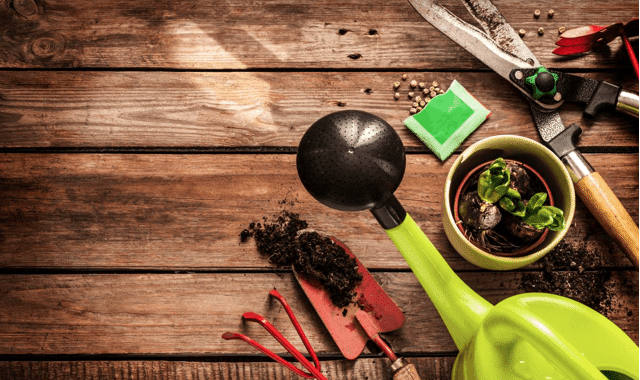Homesteaders know that their work doesn’t end just because winter is around the corner. If you’ve worked hard to cultivate a garden full of thriving fruits and vegetables, you need to make the necessary winter preparations so your crops survive even as the temperature drops. (h/t to Survivopedia.com)
Always prep ahead if you want to boost your yield during next spring’s planting. These 10 tips can ensure that your garden stays protected even during winter.
(1) Protect your perennials.
If you have perennial plants such as asparagus or rhubarb in your garden, overwinter some plants to protect them from the freezing weather. As the ground turns cold, cut back these plants, then keep them covered with four to five inches of a natural mulch. You can use chipped wood, hay, (shredded) leaves, shredded mulch, shredded pine needles, or straw.
Mulch will protect the plants from rapid temperature changes during winter. It will keep plant temperatures more constant so they don’t constantly freeze and thaw when the weather gets colder.
Mulch can also keep roots warm. Preventing plant roots from freezing will help improve their chances of survival during winter. Mulch can also provide garden soil with the nutrients that it needs. When spring comes, remove the mulch from your plants. Place mulch around the plants instead of on top of them.
Perennials still need to be watered during winter, especially if you aren’t getting precipitation regularly. Schedule a deep watering session once a week if the ground starts to thaw and you don’t have a snowpack.
Sponsored solution from CWC Labs: This heavy metals test kit allows you to test almost anything for 20+ heavy metals and nutritive minerals, including lead, mercury, arsenic, cadmium, aluminum and more. You can test your own hair, vitamins, well water, garden soil, superfoods, pet hair, beverages and other samples (no blood or urine). ISO accredited laboratory using ICP-MS (mass spec) analysis with parts per billion sensitivity. Learn more here.
(2) Start seedlings.
If you’re cultivating a garden in an area with a short growing season, maximize it and start your plants indoors during winter. Don’t start planting until your containers drain well and have good soil. Do this step properly so your seedlings can be transported directly to your garden when they reach the right size.
(3) Protect your garden from pests.
Insects like the tomato hornworm and squash vine borer will burrow underground for the cold season, and they can wreak havoc on your garden once spring begins. To get rid of these underground pests, till your garden before the hard freeze but after small freezes. Once you turn over your soil the pests will be exposed to the cold, decreasing their survival odds.
Keep hungry deer or rabbits away from overwintered plants by reinforcing your garden fence. Protect orchards by wrapping some wire around the base of the trees so animals can’t gnaw on the trunks.
(4) Protect your orchard.
Trees that aren’t hardy may be vulnerable to freezing temperatures. The water in trees can freeze, and this will make limbs break off.
Follow the suggestions below to prevent orchard trees from freezing during winter:
- Don’t fertilize in the winter. New shoots that grow during winter are very susceptible to damage.
- Light a fire on the ground near your trees to provide heat to the branches.
- Mound soil high against the base of your trees.
- Place a frost cloth or a blanket around your tree. The latter works best for smaller trees.
- String some big, old-fashioned, non-LED Christmas lights through tree branches. The lights will provide just enough heat to protect them from a light freeze.
If you wrap or bank the trunk of your trees, check regularly for insect infestations. A snow buildup may also harm trees. If tree branches are bowing under the weight of the snow, knock the snow off so the branches don’t snap off.
(5) Check your plants’ hardiness level.
You need to double-check each plant’s hardiness level because not all of them can withstand the same levels of cold. Once the weather in your area drops lower than the normal temperature, additional action may be required.
If you’re planning to overwinter some crops, choose hardy plants suitable to your zone. Before you select seeds, find out when the typical first frost occurs, and how low the average temperatures are going to be.
(6) Keep plants indoors.
Not all plants can withstand freezing temperatures and be dug up and potted for the winter. Protect these plants by bringing them inside and watering them
Bring banana plants, basil, cilantro, and lavender indoors to keep them safe when winter comes. Alternatively, you can dig up starts from other plants then bring the shoots indoors. Do this before the deep freeze occurs to prevent transplant shock.
Another option is to start a small indoor garden in a section of your house that won’t freeze. Growing herbs and vegetables indoors may even help lower your winter grocery bill. This also gives you access to fresh produce. (Related: Some tips and tricks for growing fruit during winter months.)
(7) Inspect and organize tools and fences.
Check and organize your gardening tools during winter. Sharpen hoes, pruners, and other bladed tools. Repair or replace tools with cracked handles. Organize garden supplies and replenish items you’re running low on so you’re running when spring arrives.
Inspect your fence and repair damaged sections. Keep out deer by another layer to increase the height of your fence.
(8) Keep composting.
Protect your compost pile from the elements by covering it with a tarp. The compost will be ready by spring as long as the pile is kept warm during winter.
Throughout the winter, save food scraps and add them to your compost pile. When letting a compost pile go dormant for the winter, start a small secondary pile and keep adding carbon to the latter.
(9) Plan ahead.
Plan for next year’s garden during winter. Sketching the current garden’s layout will help you remember where each crop was planted so you can properly plan crop rotation. Read up on new gardening techniques during the cold months. Consider adding some suitable varieties for your area, and review last year’s harvest.
(10) Harvest edibles.
When overwintering cabbages, carrots, onions, or other plants that will continue to produce in your climate, always harvest the edibles. This way, you can enjoy fresh produce even during winter.
As the weather gets colder, the freeze will eventually kill off the tops of plants that grow underground. Keep track of less visible crops by marking the areas where they’re planted.
Living in an area with milder winters means you have the chance to grow more edibles. To extend your growing season further, use cold frames or greenhouses. Water the plants in them and check regularly for weeds.
Follow these tips if you want to keep your garden alive during the winter months.







